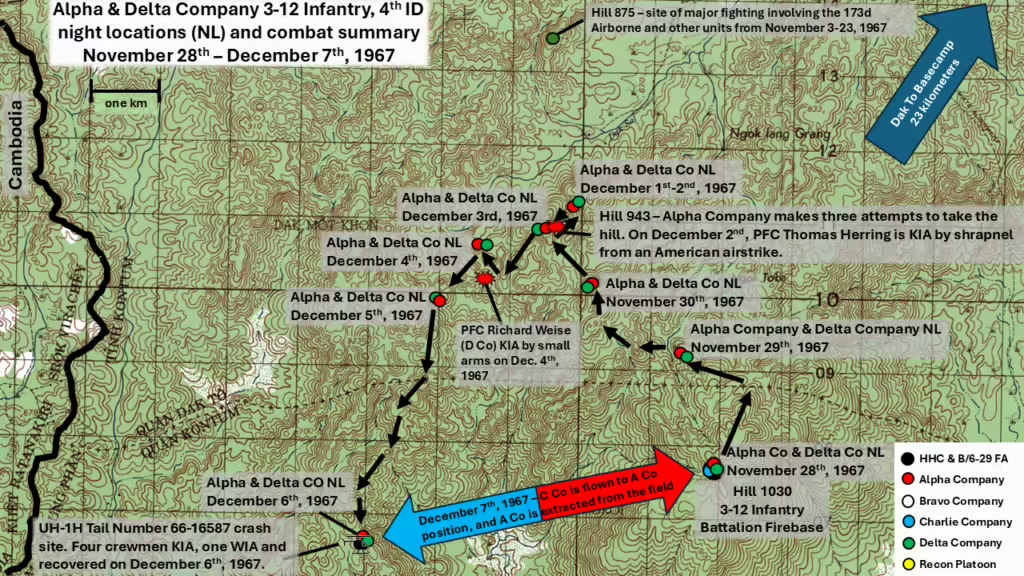The following summary was compiled from information gathered from battalion Operations Daily Journals, 4th Infantry Division Operational Readiness Report Lessons Learned, casualty and other records. These daily summaries are not the complete story of each day, just a brief description of the items noted in the journals and logs. Each soldier present in the battalion during these days experienced different things, and even being just a few feet away from each other sometimes can lead to very different perspectives. From November 30th to December 3rd, a CBS news crew filmed elements of the 3-12 Infantry in action. The special news report, aired in June of 1968, is available on YouTube. Searching “Hill 943” will produce several versions of the news report.
November 28th, 1967
Alpha Company is lifted from the battalion firebase at Hill 530 and inserted into a new position on top of Hill 1030. The infantrymen of the 3-12 and artillerymen of Bravo Battery, 6th Battalion, 29th Artillery Regiment quickly get to work establishing a new battalion firebase. The hill, named for its height in meters, will provide a perfect firing platform for the 105mm guns of Bravo Battery. Bravo, Charlie and Delta Companies are also inserted on the top of the hill. Bravo & Charlie Company focus on construction of the firebase, while Alpha, Delta and the Recon Platoon move to night positions nearby and prepared to begin search and destroy operations.
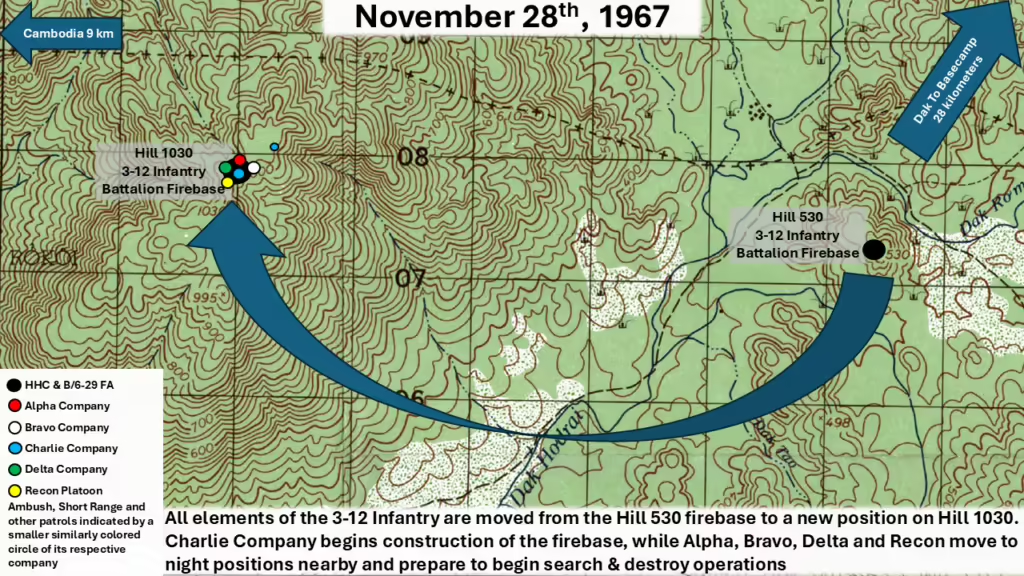
November 29th, 1967
On the morning of the 29th, Alpha & Delta Company moved off Hill 1030 and headed north. At 816086, Alpha Company discovered an empty NVA position consisting of at least 10 foxholes and one bunker. Estimated to be less than one week old, it’s apparent that the NVA had at least partially occupied the Hill 1030 area. The two companies continued patrolling and headed west towards Hill 935. The units halted short of the base of the hill and established a Night Defensive Position (NDP) at grid 814092. At 2204 hours, a listening post (LP) 125 meters out from the south side of the perimeter reported hearing 12-20 rounds of automatic weapons fire and movement. An hour later, a Delta Company LP on the southeast side of the perimeter reported more movement, estimated to be 50 meters away from the LP position. No further findings are reported in the log, and the rest of the evening passed uneventfully.
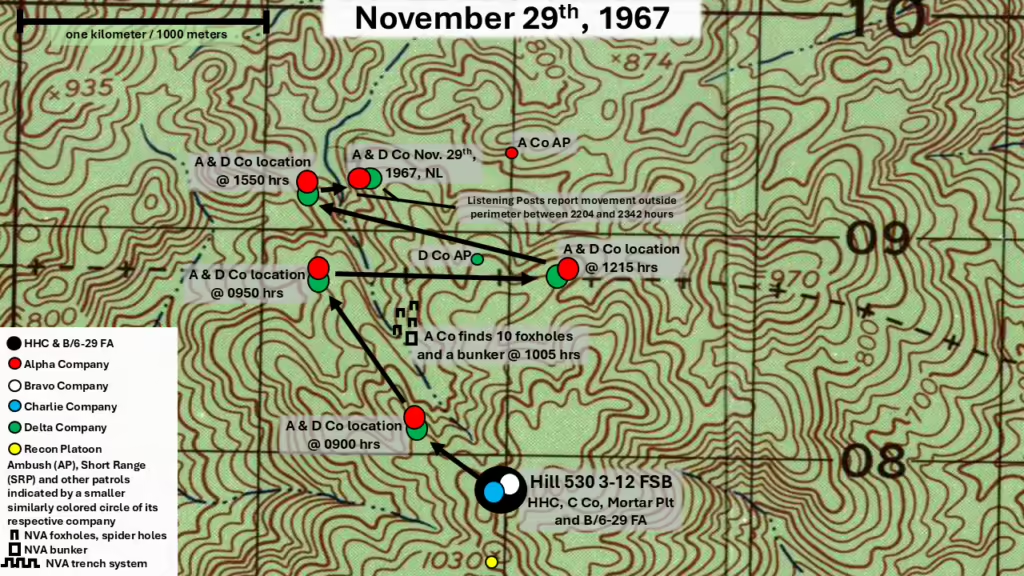
November 30th, 1967
At 0835 hours, Alpha & Delta moved out from their NDP, with Alpha in the lead. The two units moved westward down through a shallow streambed and towards the base of Hill 935. At 811094, the Alpha Company commander reported finding fresh footprints crossing the streambed going east to west. Just 1500 meters north of the Alpha & Delta company patrol, Lieutenant Colonel Jamie “Grizzly” Hendrix is aboard Ghostrider 154 performing a visual reconnaissance of the area south of Hill 943. A burst of .51 caliber machine gun fire burst up from the jungle below, peppering the UH-1H Huey. A single round punctured a radio and metal clipboard in front of Grizzly and exploded a colored smoke grenade next to him. A small piece of shrapnel sliced open his cheek, and the cabin of the helicopter filled with colored smoke. The pilot quickly changed course and headed for the battalion firebase to assess the damage. Amazingly, this event was captured by a CBS camera crew, who happened to be on board filming.
Delta & Alpha continued patrolling and vectored north towards Hill 943. They crested Hill 935, found it unoccupied and continued north an additional 400 meters before establishing an NDP at grid 801100. Both companies sent out ambush patrols for the night. Alpha Company personnel status was 100 enlisted men and three officers. Delta Company status was 107 enlisted and four officers, with an additional three men attached from other units. The night passed uneventfully.
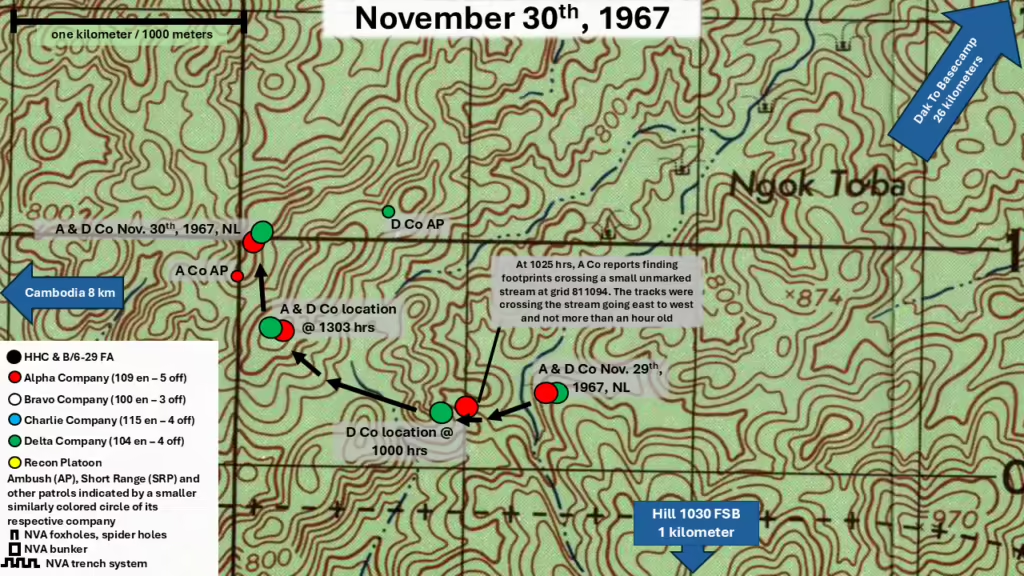
December 1st, 1967
Alpha & Delta began the day by receiving helicopter resupply at their NDP. Seven soldiers, fresh from R&R or just beginning their tours in Vietnam, were dropped off and assigned to Alpha Company. At 0945 hours, the two companies began moving north, with Alpha in the lead once again. The two units moved southwest towards the base of Hill 943. Alpha Company reported multiple fresh trails leading towards the peak of the hill. At 1255 hours, Alpha discovered a trench line, four bunkers and a helmet liner. It is obvious that the NVA have developed Hill 943 into a formidable fighting position, and LTC Hendrix ordered the units to slow their movement. Earlier in November, both Alpha and Delta Companies had experienced heavy fighting and casualties while taking Hill 1338 and its surrounding hilltops. Although the experience was costly, several important lesson were learned. No reason to rush into an NVA ambush here.
As Alpha slowly made its way uphill, a massive NVA bunker complex is discovered. Consisting of at least 20 bunkers with connecting trench lines leading to tunnels, a heavy NVA presence is likely. However, the NVA seemed to have left these positions undefended. Regardless, Delta Company closes the distance between the two companies in order to be in a better position to reinforce if the NVA do engage. Over two hours after the first NVA positions were found, an Alpha Company patrol finds another tunnel system and hears movement, but does not engage. At 1535, an Alpha Company patrol reported two NVA approaching from 30 meters away. Once again, the enemy soldiers slip away before Alpha can engage them. LTC Hendrix ordered Alpha & Delta to move off of the hill. He then deployed air strikes and artillery to soften up any hidden NVA positions before the two companies attempt to take the hilltop on December 2nd.
The units moved northeast and establish a new NDP at 799112, roughly 300 meters from the peak of Hill 943. Both companies sent out night ambush patrols. At grid 801115, the Alpha Company patrol found an additional 30 bunkers, including sleeping quarters, a kitchen, barber shop, water containers, mortar and machine gun positions and commo wire stretching towards the top of the hill just east of the NDP. This NVA complex was the source of ground fire on November 30th that struck the 3-12 Infantry Command & Control helicopter as it orbited above. The Alpha Co AP established an overwatch position in hopes that NVA elements may wander back in to the abandoned bunker complex. Alpha Company personnel status was 107 enlisted soldiers and four officers.
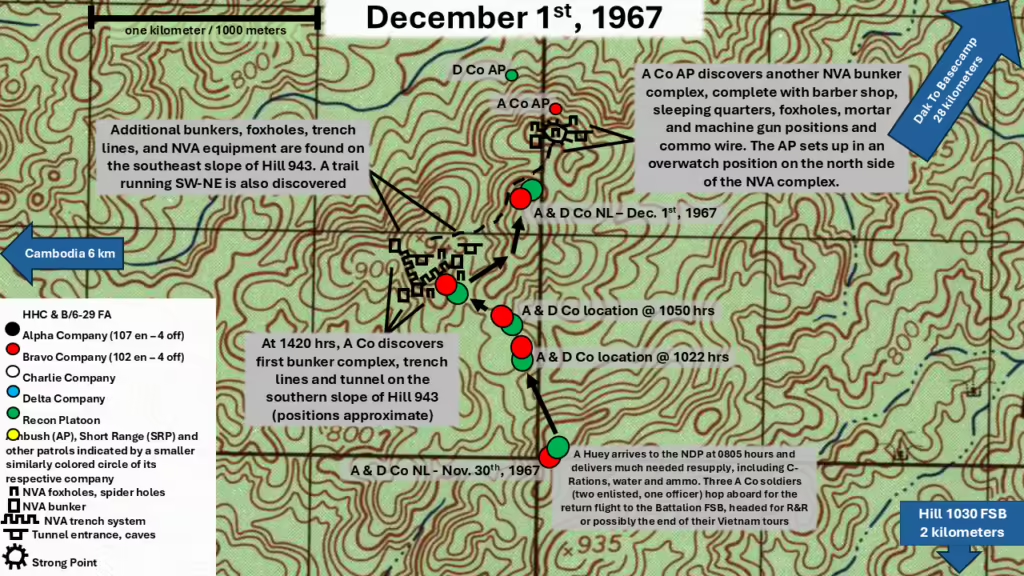
December 2nd, 1967
On the morning of December 2nd, Alpha & Delta Companies were given different missions. Delta Company would move northeast, and clear a 900 meter hill and surrounding slopes. Alpha Company would move towards Hill 943 to the southwest, but hold short and wait for artillery and airstrikes to continue to soften the NVA positions spotted on December 1st. Delta Company made quick work of their mission, and spent the entire morning discovering empty bunker complexes, trenches and trails.
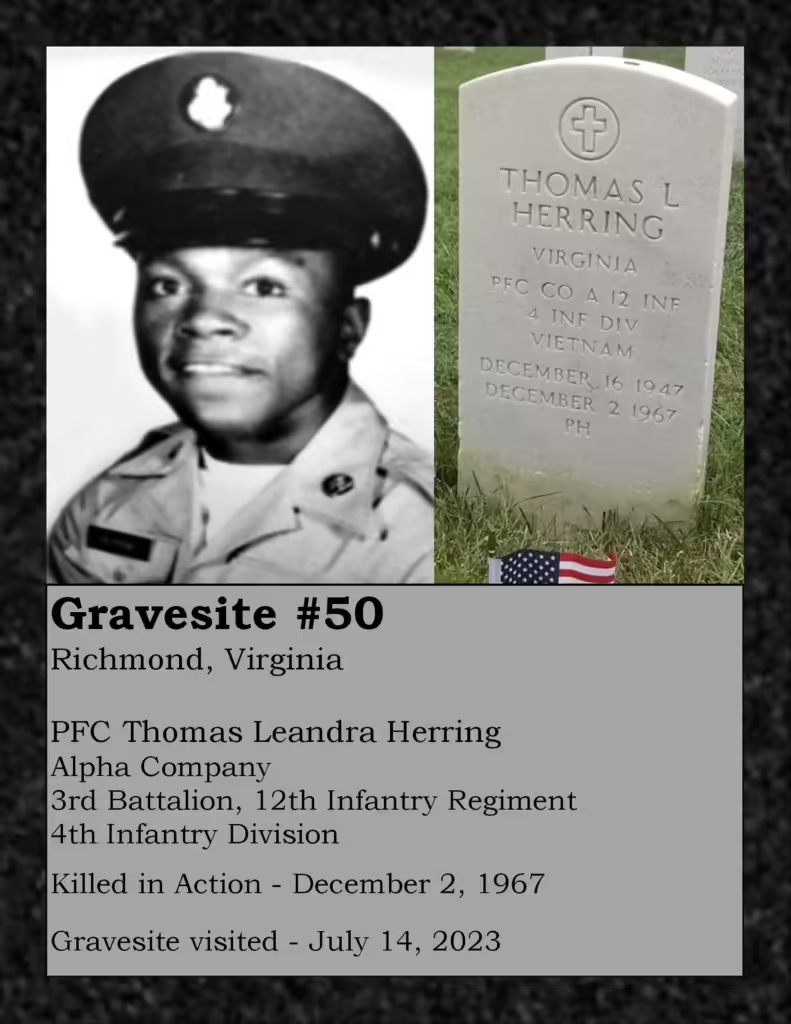
After a morning of “softening” by air and artillery assets, Alpha Company began its movement up the slope of Hill 943. The lead element was engaged by NVA snipers at 1226 hours. Several men were wounded, including PFC Terrel Hayes. As additional air strikes are called in, the Alpha Company men hugged the ground and waited for the all clear. A bomb dropped by an Air Force fighter bomber exploded in the trees in front of the forward elements of Alpha Company, showering them with razor sharp shrapnel. PFC Thomas Herring from Richmond, Virginia, just 93 days into his 365 day tour, was struck in the head by a jagged piece of metal. He is killed instantly.
Alpha Company once again waits as additional air strikes are laid in Hill 943. A Huey “Dustoff” helicopter arrived to evacuate the casualties. LTC Hendrix ordered Alpha to withdraw back to their December 1st NDP and link up with Delta Company, which has completed the destruction of the NVA positions on the adjoining hilltop. At 2106 hours, an Alpha Company LP on the west side of the position reported small arms fire roughly 50 meters away, but the rest of the night passed uneventfully.
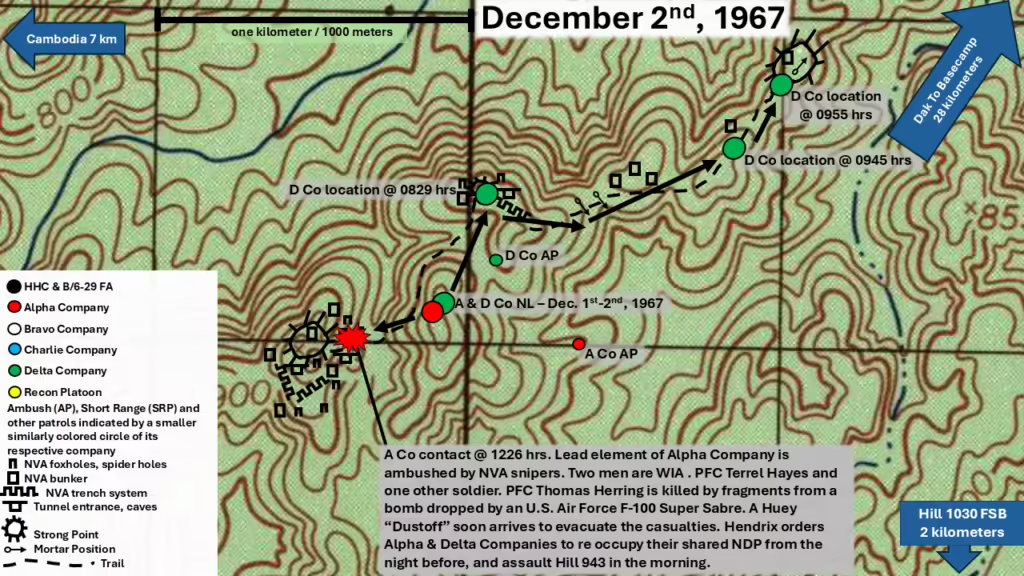
December 3rd, 1967
As dawn breaks on the 3rd of December, nightly listening posts and small ambush patrols sent out by both Alpha & Delta Company return to the joint perimeter. The roughly 200 men of the two companies stirred from their foxholes and began to prepare themselves for an assault on Hill 943. Air strikes and artillery fire alternated blasting the hillside to their west. Sometime before 1100 hours, two artillery shells fired by an American artillery unit supporting the assault, fell short of their target, and tear into the Alpha & Delta Company position. At least nine men were wounded, some seriously. 2LT Mike Lawton, SFC Ronald Beaty and SP4 Archie Brown number among the wounded. An urgent dustoff was called in, and the nine men evacuated from the field.
Shaking off the unfortunate friendly fire incident, Alpha Company began pushing towards the hilltop. The platoons, advancing on line, lay down covering fire as they go, hoping to keep the NVA soldiers heads down while they assault uphill. No return fire was received, as the NVA have slipped away. By 1235 hours, the first Alpha Company patrol has reached the top of the hill. The rest of the company soon summits the hill, and is then joined by Delta Company. The two units established a joint NDP amongst the abandoned NVA positions, some of which have been destroyed by American air and artillery strikes.
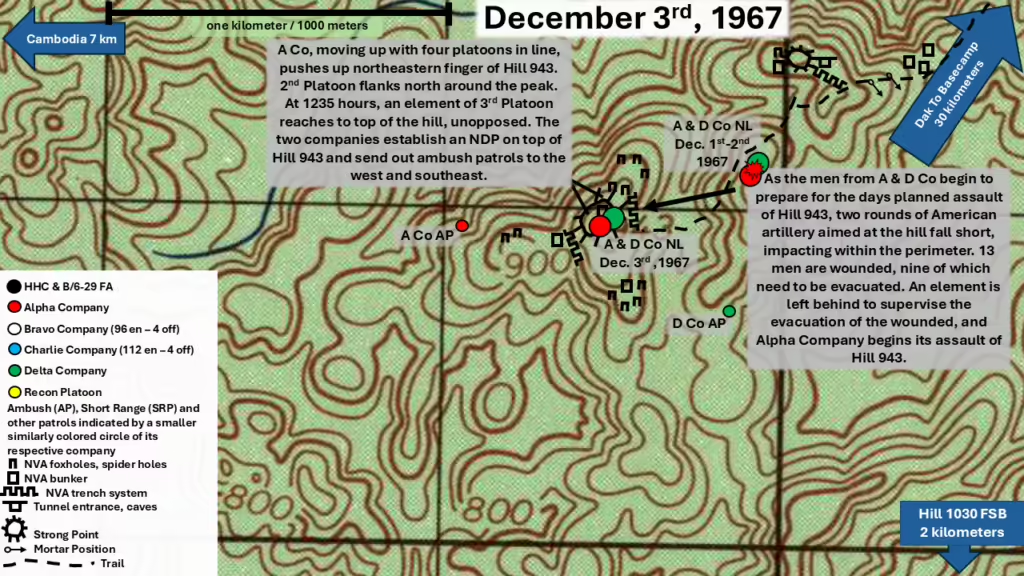
December 4th, 1967
On the morning of the 4th, Alpha Company was able to fully explore the abandoned NVA positions around the peak of Hill 943. The presence of at least two mortar positions, six trench lines, 10-14 caves, 25 bunkers and 40-50 foxholes and spider holes confirms that it was built for at least a battalion sized element. The NVA likely occupied the position for a day or two, but the constant barrage of airstrikes and artillery forced them to flee. Two NVA rucksacks, three entrenching tools, 8-10 powder bags for a 60mm mortar and spent 7.62mm cartridges are also discovered.
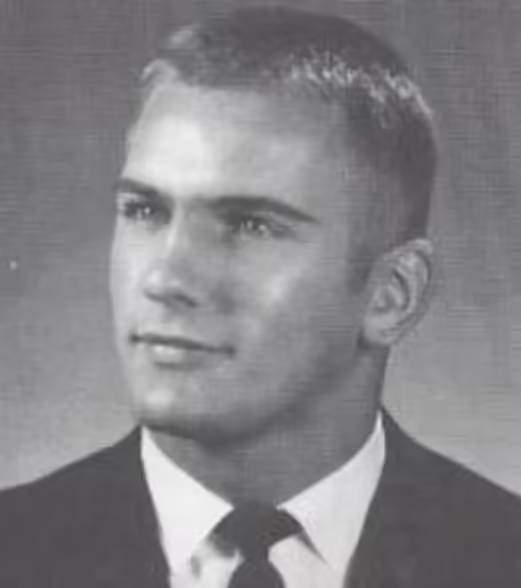
As Alpha Company finishes sweeping the area, Delta Company began to move west towards a new NDP. It isn’t long before Delta makes a significant finding. An NVA prisoner is captured at 1223 hours. He is quickly interrogated in place before being lifted out of the jungle and brought rearward for further exploitation. Alpha competes its work on Hill 943 and moved west with orders to establish a new NDP and wait for Delta to join them. At 1458 hours, the point element of Delta Company was hit with small arms fire. PFC Richard Weise is hit. Every attempt to recover him is stymied by the heavy NVA fire, and the element is forced to withdraw towards the rest of Delta Company.
Delta pulled back and joins Alpha Company at an NDP at grid 785107. Alpha sent out a single ambush patrol to the northeast, which positions itself along the trail that brought them to the NDP. If the NVA have trailed Alpha Company, they will find a nasty surprise waiting for them in the form of an Alpha Company ambush.
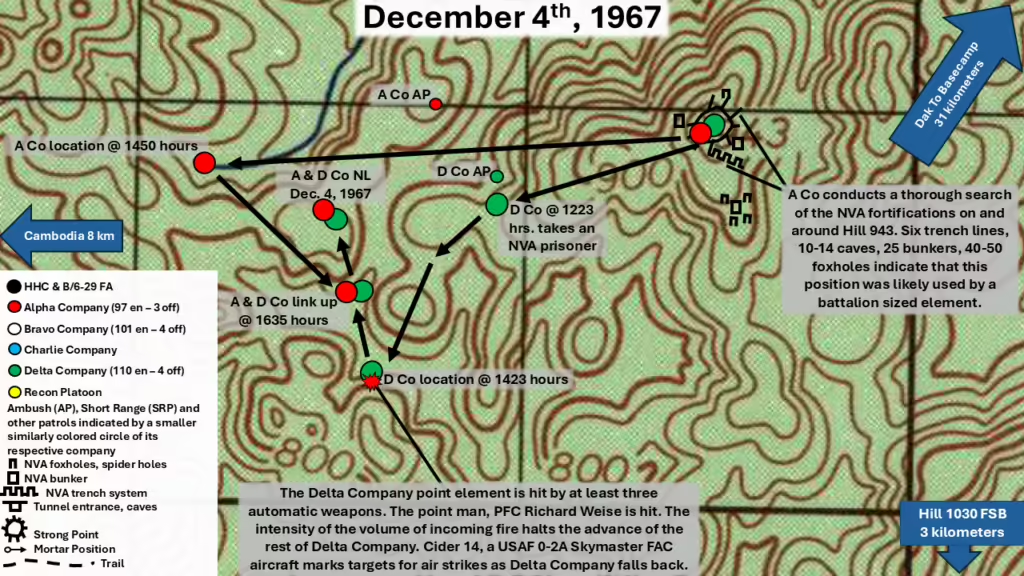
December 5th, 1967
The Alpha Company ambush patrol located to the northeast passed the night uneventfully, and rejoined the company at 0805 hours. Delta Company, eager to get back to the site of the previous days action and search for their missing man, has already departed the night location. Alpha Company, in a trail position, prepared to reinforce Delta if necessary. At 0815 hours, Delta Company found the body of PFC Weise very near where he was last seen on December 4th. Delta Company also discovered another set of NVA fortifications. Not as large as the one on Hill 943, but extensive nonetheless. At least six bunkers were found, as well as a large cache of NVA weaponry. Five rifles, two 7.62mm machine guns, nine Chicom mines, two anti-tank mines, 35 75mm Recoilless Rifle (RR) rounds, 225 82mm mortar rounds, one B-40 rocket and launcher and 18 cases of US manufactured 7.62mm ammunition. Alpha Company moved up to assist in the search and clear operation, and discovered eight additional 75mm RR rounds and 40 82mm rounds. The two units destroyed much of the equipment in place before moving out once again. Alpha took the point position, and the two units moved roughly 600 meters to the southwest before establishing an NDP at 780099.
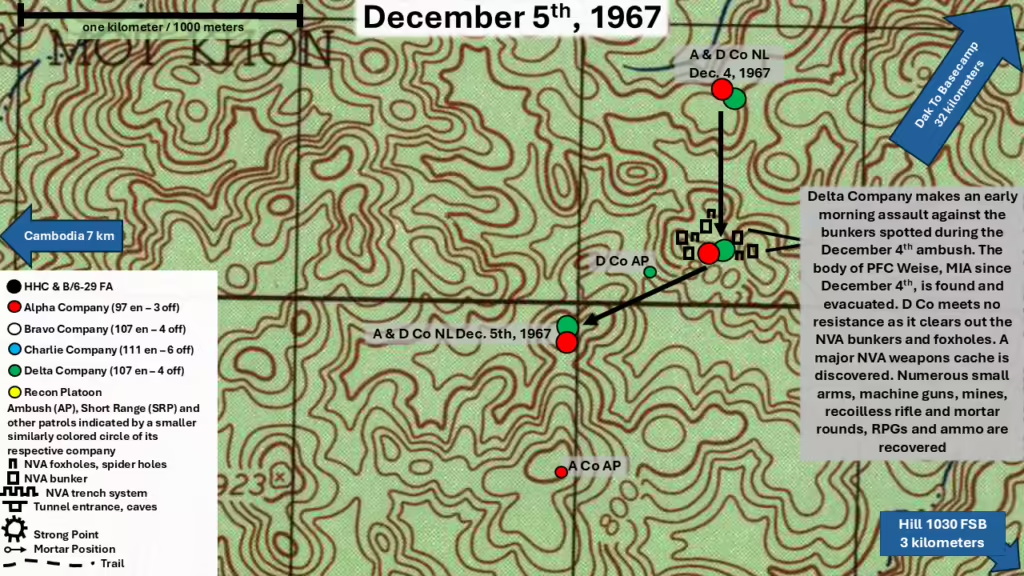
December 6th, 1967
Alpha & Delta Company received a change in mission. On December 4th, a UH-1H Huey helicopter belonging to Alpha Company, 4th Aviation Battalion disappeared in the vicinity of grid 772055. Alpha & Delta Companies were ordered to move quickly in that direction, in the hopes of finding the crash site and possible survivors. Although the suspected crash site was less than four kilometers away, it would take most of the day to cover that distance. Wary of NVA ambushes, and slowed by the thick jungle and steep mountains, the two companies would have to move steadily, but carefully.
Delta Company took the lead, and pushed generally south, following an 800 meter ridgeline. Just before noon, the two units discovered an abandoned NVA bunker system, which looked to have been constructed some time ago, but used recently. The units reported it to higher headquarters and continued moving south, not stopping for a more thorough investigation. After an additional three hours of moving steadily along the ridgeline, the two units reached their proposed night location. Small patrols fanned out from that location, looking for the crash site.
At 1615 hours, a Delta Company element discovered the downed helicopter at 770067. Alpha Company, which had been following Delta the entire day, joined with Delta at the crash site. The two units surrounded the crash site with a defensive perimeter. Soldiers from Delta quickly discover the bodies of three of the crewmen. Miraculously, one crewman, Warrant Officer Charles Livermont, the Aircraft Commander, trapped and alone in the crashed helicopter for over 48 hours, was still alive. An engineering team was flown in to assist in extracting him from the wreckage. There was still one crewman missing, but darkness limited the search efforts. Alpha & Delta sent out ambush patrols to the west and south of their NDP, and will pick up the search again in the morning.
Alpha Company status was 97 enlisted and three officers. Delta Company status was 107 enlisted and four officers.
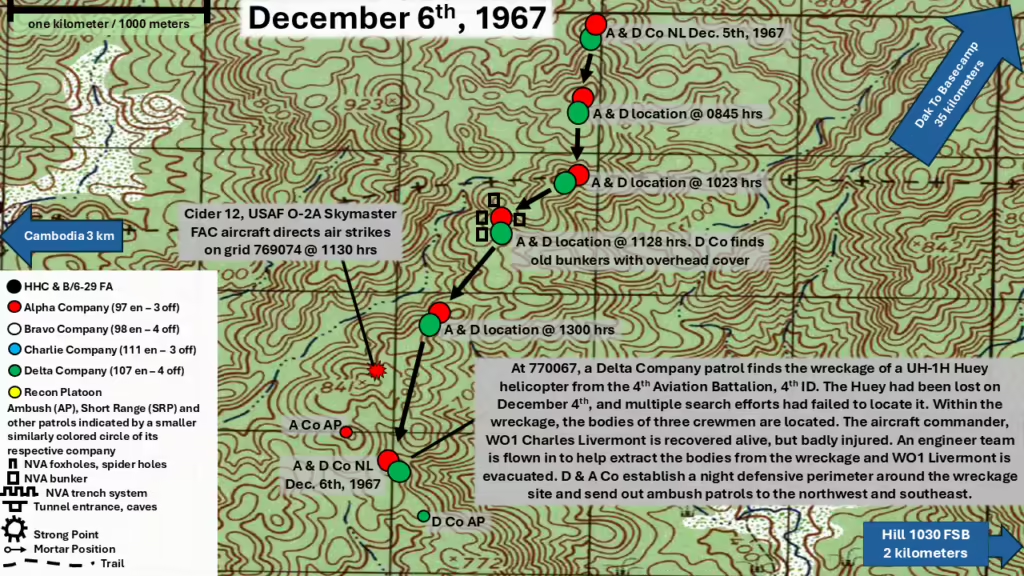
December 7th, 1967
As soon as dawn breaks, the men from the 3-12 Infantry fanned out and began their search for the fifth and final crewman. At 0805, an element of Alpha Company finds the missing man, who is dead but was thrown free of the helicopter as it crashed. Soon after reporting the discovery of the last crewman, Alpha Company receives an order to prepare to be lifted out of the jungle.
Charlie Company, which has been on firebase security for the last 10 days, will be flown out to a landing zone at the Alpha/Delta position. Alpha will be brought back to the battalion firebase to assume Charlie Company’s role, and Charlie will begin a multi-day search and destroy mission of their own. At 1127 hours, UH-1H Hueys of the 170th Assault Helicopter Company (callsign “Bikini”) began arriving with Charlie Company soldiers on board, and by 1247, the extraction of Alpha Company is complete.
The men, tired from nine straight days in the jungle, most of which involved at least light contact with the enemy, happily settled into foxholes and bunkers around the battalion firebase perimeter. For the next five days, they would have a chance to eat a hot meal occasionally, catch up on their letter writing, and maybe even get a fresh uniform or change of socks.
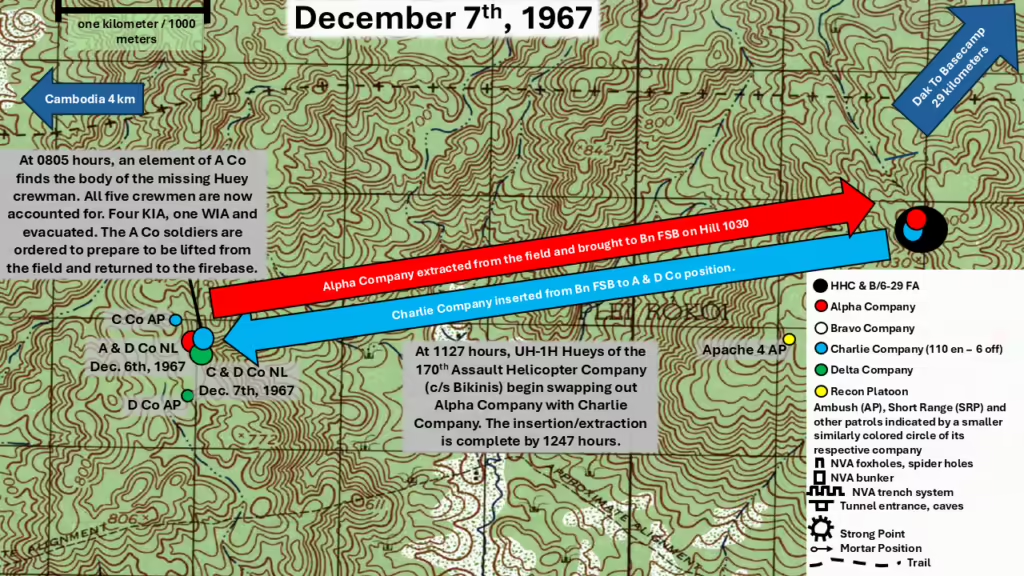
Summary
Alpha & Delta Companies of the 3rd Battalion, 12th Infantry Regiment spent from November 28th to December 7th, 1967 on a combined operation. They covered over 15 kilometers of ground, much more if you take in to account the ground covered by flanking and small element patrols while on the march, as well as the nightly ambush patrols. The shortest distance covered in one day was December 1st, when A Co moved less than 500 meters from the NDP to Hill 943, before they were ordered to withdraw and wait for another day of “softening up” air and artillery strikes. The longest distance covered in one day was December 6th, when the two companies were ordered south to search for the downed Huey from the 4th Aviation Battalion. The two companies covered close to four kilometers in roughly seven hours.
The two companies encountered at least minor contact with the enemy on six days of the 10-day patrol. During that time, the units suffered roughly 20 men wounded in action or injured, and two men were killed in action.
Alpha Company would begin a five day stretch as “palace guard” on December 7th, allowing the men to rest and recover in slightly more comfortable conditions that what they had experience over the 10-day patrol. Delta Company would spend another five days in the field being flown to the firebase to replace Alpha Company.
